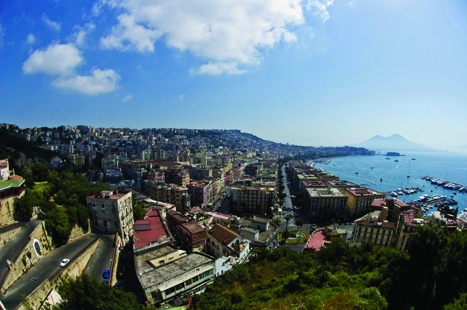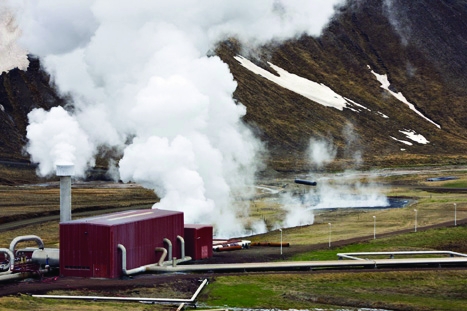Volcanoes have shaped the world - and caused devastation in their wake. In Southern Europe they are a constant threat - the effects of a large eruption could destroy buildings and infrastructure; engulf and incinerate agriculture; and wipe out populations. Around Naples, the remains of Pompeii and Herculaneum are a constant, grim reminder of what the looming presence of Mount Vesuvius could do to the city.
Vesuvius isn’t the only threat in the area, however. Less well known but even larger is a formation called Campi Flegrei, a 13km-wide crater that sits on top of an active magma chamber, whose name roughly translates as ’burning fields’. The last eruption in Campi Flegrei was in 1538, but for the past 40 years the ground in the area has been swelling - an ominous omen that another eruption could be imminent.

The potential danger and the fact that little is known about this kind of volcano, which is known as a caldera, has led to plans to drill into Campi Flegrei to insert sensors that will allow scientists to locate the magma chamber precisely and find new data on the conditions around and inside it. But the project is proving controversial - opponents fear that the drilling could release heavy metals and other pollutants to the surface, or could trigger seismic events or another eruption.
Ask someone to draw a volcano and they’re likely to sketch out the classic conical mountain with smoke and lava coming out of the top. These eruptions can be cataclysmic enough - Mount St Helens in the US in 1980, Eyjafjallajökull in Iceland this year, and, indeed, Vesuvius in 79AD all prove this. But caldera volcanoes have the potential to be even worse.
Calderas are formed when a large volcanic eruption completely empties a magma chamber. The ground above collapses, forming a ring-shaped fault line and a large, shallow depression. But if volcanic activity continues, the centre of the depression can be pushed upwards and eventually can erupt again. When this happens, the results can make other volcanoes look like firecrackers.
Campi Flegrei formed some 39,000 years ago; the explosion that led to its creation sent ash as far as Moscow. The last time a caldera of comparable size erupted was in 1816, in Indonesia. It killed more than 70,000 people - more than 11,000 as a direct result of the eruption - and sent enough ash into the atmosphere to cause a ’volcanic winter’. There was effectively no summer in the US and Europe, leading to crop failure and livestock death in much of the Northern Hemisphere.
The ’big daddy’ of volcanic calderas is at Yellowstone in the US. Like Campi Flegrei it is still active and its last explosion, 640,000 years ago, sent 1,000km3 of rock and dust into the atmosphere, causing long-lasting changes to the planet’s climate. Another caldera eruption, some 70,000 years ago, which created Lake Toba in Sumatra, caused a ’volcanic winter’ lasting six to seven years, and is believed to have killed off all but a few thousand members of the human race.
Small to moderate caldera eruptions represent a major risk, particularly in urban areas
The stakes, clearly, are high. ’Although very rare, such super-eruptions represent a serious threat to mankind,’ said Guiseppe De Natale of the Italian Institute of Geophysics and Vulcanology (INGV), who is leading the drilling project. ’However, small to moderate eruptions represent a major risk as well, particularly in urban areas.’ The area around Campi Flegrei is highly urbanised, with Naples nearby and many smaller towns and villages. Indeed, between 1982 and 1984 the ground was rising at a rate of 1m/yr, leading to the temporary evacuation of 30,000 people from the town of Pozzuoli, which lies above the centre of the caldera.
The project plans to drill at Bagnoli, an area near Naples on the eastern part of the caldera. De Natale hopes to penetrate down to 500m in a pilot phase, starting this month. Next spring, the main hole is to be drilled, reaching down to 4km. Fibre-optic sensors will be placed inside the borehole, measuring temperature and strain, and therefore giving information on seismic activity and ground deformation. These will have to withstand temperatures as high as 600ºC. The team expects to hit supercritical fluids, but should come nowhere near any magma - the main chamber is believed to be 6-7km down.
’The role of deep drilling in this area is crucial,’ De Natale told the European Geosciences Union General Assembly in May this year. ’It could give a fundamental, precise insight into the substructure, the geometry and character of the geothermal systems.’ It could also provide insight into the composition and chemistry of the magma and how magma and water interact.
The drill site is some way away from the magma chamber because it will allow De Natale’s geologists to look at the structure of the rock strata that make up the caldera. Closer to the centre of the structure the strata have collapsed and the picture would be confused. However, the relatively shallow level of the magma chamber is another factor that makes Campi Flegrei a good site for study. Extrapolating the temperature profile down the borehole will give a precise location for the magma.
Building sensors that can withstand such conditions is extremely challenging. Some of the most promising are made from silicon carbide (SiC), which has semiconducting properties similar to those of elemental silicon, but is also very resistant to many forms of radiation, including heat - while silicon-based electronics work up to 175ºC, SiC continues to function above 600ºC.
Deep drilling could give an insight into the substructure, geometry and character of geothermal systems
SiC sensors are the subject for a large EU-funded project called SCEPTRE (silicon carbide for high-power and temperature applications), aimed at developing electronic components and sensors for space applications (particularly in planetary exploration), pollution sensing and energy conversion. One sub-project is looking at developing X-ray spectroscopy sensors for use in missions to Europa and Titan. If they can withstand that, then the conditions inside a volcano should pose no problems.
Meanwhile, De Natale believes that the Campi Flegrei project could also provide insights for geothermal energy. If superheated fluids are present, he reasons, then there’s the potential to install heat exchangers at depth to recover the energy and use it to power generating turbines. Could the risks of living near a caldera be balanced by the potential for cheap, green power? It’s a question that Neopolitans could soon have to ask themselves.
In depth - Iceland Deep Drilling Project
Iceland, with its notoriously volcanic landscape, is also housing a deep-drilling project with the aim of investigating geothermal power. However, the Iceland Deep Drilling Project hit a snag last summer, when it unexpectedly encountered a molten magma chamber.
The project, based at Krafla, a 10km-wide caldera volcano in the north of the island, aims to drill down 4.5km into the volcano to investigate the conditions of supercritical fluids trapped in the rock. The volcano already powers a 60MW power station, which has been operating since 1977.

However, towards the end of June 2009, the drill encountered molten rock at a depth of just 2.1km. The drill was stopped and studies into the situation are continuing, with tests of the fluids at that depth and their characteristics. The most recent flow tests, in July, showed that the well is discharging 30kg/sec of dry, superheated steam, corresponding to 30MW of electric power.




Glasgow trial explores AR cues for autonomous road safety
They've ploughed into a few vulnerable road users in the past. Making that less likely will make it spectacularly easy to stop the traffic for...